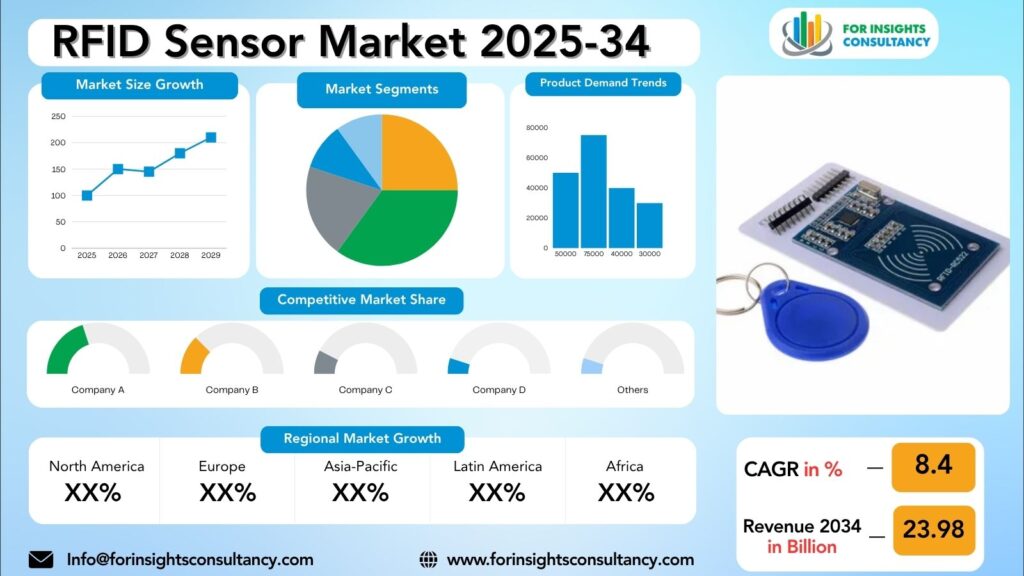
RFID Sensor Market Size, Trends Analysis Research Report by Frequency (Low Frequency (LF), High Frequency (HF), Ultra High Frequency (UHF), Microwave Frequency), by Type (Passive RFID Sensors, Active RFID Sensors, Semi-Passive (Battery-Assisted) RFID Sensors), by Application (Asset Tracking, Inventory Management, Supply Chain Management, Healthcare & Pharmaceuticals), and By Region Global Market Analysis And Forecast, 2025-2034
Oct-2025 Formats | PDF | Category: Electronics & Semiconductor| Delivery: 24 to 72 Hours
RFID Sensor Market Is Forecast to Increase from USD 9.74 Billion In 2025 To USD 23.98 Billion By 2034, At A CAGR Of 8.4%.
RFID Sensor Market: A Comprehensive Overview and Future Developments
The RFID sensor market is seeing the increasing demand for real-time tracking and monitoring solutions across the board of-firms in the retail, healthcare, logistics industry, is the key reason for this rapid growth. The future developments of RFID sensors are even more secure data-features, more extended read-ranges, and better IoT platform integration to have more comfortable connectivity and operations.
Moreover, RFID sensors are used to track assets, manage inventories, optimize supply chains, and facilitate contactless payments, which are the factors that motivate the usage expansion in various sectors. The main contributors to the RFID sensor market are Zebra Technologies, NXP Semiconductors, Impinj Inc., and Alien Technology, which are at the forefront of innovation and market growth. Summing up, the RFID sensor market will be largely extended, supported by the industry-wide adoption of technological advancements for elevating operational capabilities and achieving efficiency improvements.
Market Insights
- In 2024, the RFID Sensor Market is projected to experience significant growth, with the largest revenue share expected to come from the North America region.
- The growth forecast for this region is promising, driven by increasing adoption across various industries. In the United States, approximately 82% of the population is expected to reside in urban areas, further boosting the demand for RFID sensors in smart city applications.
- Additionally, within the RFID Sensor Market segments, the largest revenue share is anticipated to come from the healthcare sector, followed closely by retail and logistics.
- These industries are leveraging RFID technology to enhance operational efficiency, improve inventory management, and ensure seamless supply chain operations. Overall, the RFID Sensor Market is poised for substantial growth and innovation in 2024.
Market Dynamics
Trends
More and more healthcare institutions are using this technology to keep a record of medical equipment and the patients. One point to note is that the trend of wireless device has led its integration with IoT devices which ultimately results to better inventory management and supply chain visibility.
Nowadays, the main reason for the growth of the market is the growing demand in retail for customer experience enhancement through personalized marketing strategies. The main issue for the market, which is being worked on, is enhancing data security measures to alleviate privacy concerns. RFID sensors are spreading in smart cities and will be the traffic management and public safety of the future.
Leading to the creation of advanced technologies for RFID to keep track of the right solutions in various sectors. Besides, the company has a plan to exploit the automotive and the aerospace market as two new emerging areas which they believe will benefit from their product in the terms of operational efficiency.
The most important innovations have been the reduction of the cost of the performance and the improvement of the quality of the RFID sensor through the structural design.
Growth Drivers
Retail and supply chain management are increasingly adopting RFID technology to track inventories which has given the department the opportunity to be efficient in its operations and have cost savings. Consequently, the sensor market has seen a huge demand in healthcare where it is used for patient monitoring, asset tracking, and inventory management, all of which have contributed to patient safety and made healthcare operations less complicated.
The security and authentication market has been greatly influenced by the need for stricter security measures in the automotive, aerospace, and defense sectors, among others. As a result, these have become the main reasons for implementing RFID sensors to track and identify objects. One of the main reasons for the expansion of the application scope across different industries has been the improvement of performance, reliability, and cost-effectiveness brought about by the technological advancements in RFID sensor design and functionality.
Restraints
Data Security Concerns: Since the data is transmitted wirelessly in the case of RFID technology, security and privacy are among the concerns raised.
High Initial Investment Costs: The installation of RFID sensors is a major upfront investment that includes building the infrastructure and buying the technology, which might discourage some organizations that have limited budgets.
Compatibility Issues: RFID sensors might have compatibility problems with current systems and technologies that lead to difficulties in integration and the need for extra money to upgrade or replace the existing systems.
Regulation and Compliance Challenges: Adhering to rules about RFID technology, like usage of frequency and data protection laws, can become obstacles for companies operating in different regions with various regulatory requirements.
Limited Read Range and Interference: The performance of RFID sensors might be hindered due to limited read range leading to the possibility of interference by other electronic devices, making them ineffective in certain locations.
Opportunities
One of the major factors contributing to the adoption of RFID sensors is the rising need for supply chain management solutions that are efficient. The necessity of better asset tracking as well as inventory management has become an essential focus for an array of industries. One of the main reasons for the integration of RFID sensors is the real-time data monitoring that comes with the advancements of IoT technology.
The development of the retail sector and the acceptance of contactless payment systems are two of the major factors that have led to the growth of the market of RFID sensors. The rising need for smart packaging solutions is one of the factors that have contributed to the change of the ways of product authentication and anti-counterfeiting measures in the market.
The use of RFID sensors in healthcare for patient tracking and inventory management has led to the growth of the market of RFID sensors. The automotive industry has implemented RFID technology which has brought about improved vehicle tracking and security features. The development in the design of RFID sensors has made it possible for the creation of smaller, more affordable, and hence, more widespread solutions.
Challenges
Interoperability issues: Different RFID sensor technologies may not be able to communicate with one another effectively, which results in compatibility problems.
Data security concerns: One of the biggest challenges still remains to be the security and privacy of the data that is transmitted and stored by RFID sensors in 2024.
Cost barriers: The high implementation costs associated with RFID sensors may be the reason that the technology is not widely adopted in various industries.
Regulatory compliance: Staying abreast of the changing regulations and standards that relate to RFID technology is a challenge for businesses that employ RFID sensors.
Environmental impact: The point where the ecological footprint of RFID sensor production and usage becomes a matter of concern for the organizations is in the case of sustainability. Integration complexity: The process of integrating RFID sensor data with current systems and processes may take a lot of time, money, and effort in 2025.
The issues in 2024 and 2025 with RFID technology reflect the incessant intricacies and deliberations of the market for RFID sensors.
RFID Sensor Market Top Companies Covered In This Report:
Evaluate The Strategic Positioning And Innovation Pipelines Of Leading Market Companies-From Multinational Enterprises To Disruptive Regional Firms. Understand How Key Players Are Innovating, Expanding, And Capturing Value, And Use Competitive Benchmarks To Plan Your Next Move.
- Avery Dennison Corporation
- CAEN RFID S.R.L.
- Honeywell International Inc.
- Alien Technology, LLC
- Applied Wireless
- Checkpoint Systems, Inc.
- Impinj, Inc.
- Invengo Information Technology Co. Ltd
- Motorola Solutions, Inc.
- NXP Semiconductors
- Savi Technology
RFID Sensor Market Company News 2024 and 2025
Impinj, Inc.
Its M800 series tag chips surpassed 5 billion lifetime shipments in early 2025, becoming its fastest‑growing tag chip line.
NXP Semiconductors
Introduced new RAIN RFID solutions emphasizing higher security (e.g. UCODE DNA Track, with cryptographic authentication) for inventory/supply‑chain and smart city applications.
Acquired Kinara, Inc. (~US$307 million) to strengthen its AI / Edge computing capabilities (NPUs & software enablement) to complement its processors, connectivity, security, analog portfolio.
Segmented View of The Industry:
The RFID Sensor Market Is Mapped Through A Multidimensional Lens-Tracking Shifts Across Product Type, Applications, And Geographic Regions. This Segmented Approach Enables Businesses to Localize Their Growth Plans And Align Offerings With The Most Profitable Demand Centres.
Segmentation By Frequency
- Low Frequency (LF)
- High Frequency (HF)
- Ultra High Frequency (UHF)
- Microwave Frequency
Segmentation ByType
- Passive RFID Sensors
- Active RFID Sensors
- Semi-Passive (Battery-Assisted) RFID Sensors
Segmentation ByApplication
- Asset Tracking
- Inventory Management
- Supply Chain Management
- Healthcare & Pharmaceuticals
- Retail & Consumer Goods
- Transportation & Logistics
- Manufacturing & Industrial Automation
- Agriculture & Livestock Management
- Security & Access Control
Global Geographic Coverage:
The Report Provides In-Depth Qualitative And Quantitative Data On The RFID Sensor Market For All Of The Regions And Countries Listed Below:
North America
North America RFID sensor market is anticipated to have high growth potential with the continuous GDP growth rate and a stable rate of inflation. In the United States, the main factor for the RFID sensor market is the government subsidy, which is uniquely designed to promote the adoption of technology in the logistics sector. The subsidy has turned companies into the best clients of the RFID technology, leading to a market demand increase many times over.
Most RFID sensors in North America are sold through the existing retail channel, which has the highest number of users, while the direct-to-consumer sales via online platforms is the fastest developing channel. Buyers in this region want the environment and the good practice in the sourcing of the materials to be taken into account in the production of the RFID sensors. Therefore, these aspects are considered indispensable by many purchasers. In developing markets, prices and status are the most important things, and that’s why companies are focusing on providing cheaper solutions to the broader consumer base.
The North American RFID sensor market is going through a robust increment where the principal cause of the growth is the adoption of the technology by various industries, such as retail, healthcare, logistics, and automotive. Among the countries of North America, the US market leads, and the main reasons are the presence of the top players and rapid technological development. Next to these, Canada and Mexico represent new markets mainly because of the demand for the implementation of supply chain management solutions.
The use of RFID sensors in the North American region is mainly focused on asset tracking, inventory management, and access control. Consequently, the healthcare sector is progressively implementing RFID technology for patient tracking and medication management. The retail sector in Canada is growing with the adoption of RFID for inventory visibility and loss prevention. Meanwhile, the automotive industry in Mexico is taking advantage of RFID sensors to the manufacturing process optimization and supply chain efficiency. The prospect of the RFID sensor market in America and its sub-regions remains bright with further investments in IoT and digital transition as the main drivers of the market expansion.
Europe
Europe’s RFID sensor market is forecast to grow considerably, fueled by the energetic GDP growth rate of 2.5% and a low inflation rate of 1.2%. A particular government grant in Germany, encouraging the use of RFID technology in logistics and supply chain management, is identified as one of the main factors for market growth. The leading way for RFID devices in Europe is through e-commerce platforms, whereas the most rapid-growth channel is through the tech solution providers.
The European RFID sensor market is growing dramatically, with the main reason being the usage of RFID technology in different departments. The Western part of Europe consists of countries like Germany and the UK that are at the forefront of the market and have the most impact in the RFID sensor field. The region of Eastern Europe is by all means different. Here the growth is fast after the need for modern and proper tracking and monitoring solutions is rising.
South European countries as Italy and Spain are a part of this trend and are soon to be among the significant investors in RFID technology for inventory management and supply chain optimization. Also, the Northern Europe market for RFID sensors is very important as the smart production and logistics solutions have attracted the investment of the Swedish and Finnish countries.
In general, Europe presents a great market for RFID sensors, with different sub-regions giving diverse opportunities to companies that are already working there.
Asia Pacific
It applies to the RFID sensor market in the Asia Pacific region which will be the next boom with the predicted GDP of 6% and inflation of 3%. It is the implementation of RFID technology in the supply chain that receives government subsidies in China and is the main driver for the market expansion there. The retail sector is the main source of India’s demand for RFID sensors. Meanwhile, the e-commerce sector is the quickest-rising channel that will win over the market after its rapid digital transformation.
Asia Pacific RFID sensor market is trending up significantly. The main reason for this market growth is the wide spread usage of RFID technology by the various sectors like retail, healthcare, logistics, and manufacturing. The signatories to this movement in the Asia RFID sensors are notably China, Japan, and South Korea.
The RFID sensor market is booming in China due to the Chinese government support to smart industry and the rapid development of the e-commerce business. Japan is an essential part of the RFID sensor market in the world, promoting the application of RFID technology in the medical and transport sectors. South Korea is also seeing a fast increase in the RFID sensor market. The climb is mainly attributed to the rising need for the supply chain management solutions that are efficient.
The Pacific region, on the whole, has very large potential for the players of the RFID sensor market with the presence of different sub-regions, each with their own growth possibilities and challenges.
Middle East and Africa
The Middle East and Africa region RFID sensor market is expected to expand greatly by 3.5 % GDP growth rate and 2.1 % inflation rate. The main cause for the change of RFID adoption in the UAE being the government Smart Dubai project which requires the implementation of the RFID technology for achieving the goal of the smart city. Most of the RFID sensors sales in the Middle East and Africa come from collaborations with public authorities or other government entities, while the rapidest developing channel is the sales through e-commerce platforms directly to consumers.
The RFID sensor market in the Middle East and Africa region is getting substantial momentum. The primary reason behind this is the process of RFID technology that is taking place in all kinds of organizations where that technology is usually required. In the United Arab Emirates, the United Arab Emirates, Saudi Arabia, and Qatar are the main contributors to the growth of the RFID sensor market in the Middle East. All these nations are largely dependent on improving their supply chain’s productivity and safety, and this is what is pushing the demand for the RFID sensors.
The African continent includes the countries of South Africa, Nigeria, and Kenya, which are all regions that have been embracing RFID sensor technology in the healthcare, transport, and retail sectors. The aforementioned nations are utilizing RFID technology to achieve better inventory accuracy, asset tracking, as well as, gaining operational efficiency holistically.
Therefore, the Middle East and Africa region is an attractive market for RFID sensor vendors with various possibilities in the different parts of the region for further developments and expansion.
Frequently Asking Questions
What is the RFID Sensor market size and growth forecast?
RFID Sensor Market Is Projected to Reach USD 23.98 Billion by 2034, Growing from USD 9.74 Billion In 2025, At A CAGR Of 8.4% During The Forecast Period.
Who are the key players in the RFID Sensor market?
The RFID Sensor Market Includes Major Companies Avery Dennison Corporation, CAEN RFID S.R.L., Honeywell International Inc., Alien Technology, LLC, Applied Wireless, Checkpoint Systems, Inc., Impinj, Inc., Invengo Information Technology Co. Ltd, Motorola Solutions, Inc., NXP Semiconductors, Savi Technology, Others.
What are the current and future trends for RFID Sensor market?
Current trends in the RFID sensor market include increased adoption in supply chain automation, inventory management, and cold chain tracking using passive UHF and NFC tags. Future trends point toward integration with IoT platforms, AI-driven analytics, and growth in battery-free, high-frequency, and secure RFID systems for smart environments.
Which regions dominate the RFID Sensor market?
North America and Asia-Pacific dominate the RFID sensor market, driven by strong adoption in retail, logistics, and manufacturing sectors. China, the U.S., and India are key contributors due to large-scale digitalization and government-backed automation initiatives.
What are the challenges facing the RFID Sensor market?
The RFID sensor market faces challenges like high implementation costs, signal interference, and integration issues with legacy systems.
Valuable Points from RFID Sensor Market Research Report 2025-2034
- Significant changes in Market dynamics.
- Reporting and assessment of recent industry developments.
- A complete background analysis, which includes a valuation of the parental RFID Sensor Market.
- Current, Historical, and projected size of the RFID Sensor Market from the viewpoint of both value and volume.
- RFID Sensor Market segmentation according to Top Regions.
- RFID Sensor Market shares and strategies of key Manufacturers.
- Emerging Specific segments and regions for RFID Sensor Market.
- An objective valuation of the trajectory of the Market.
- Recommendations to Top Companies for reinforcement of their foothold in the market.
Customized Report as per your Business Needs
- Our analysts will work directly with you and understand your needs
- Get data on specified regions or segments, competitor and Vendors
- Data will be formatted and presented as per your requirements
Any Requirement Contact Us: Https://Www.Forinsightsconsultancy.Com/Contact-Us/
Table of Contents
For TOC Contact us: https://forinsightsconsultancy.com/contact-us/






